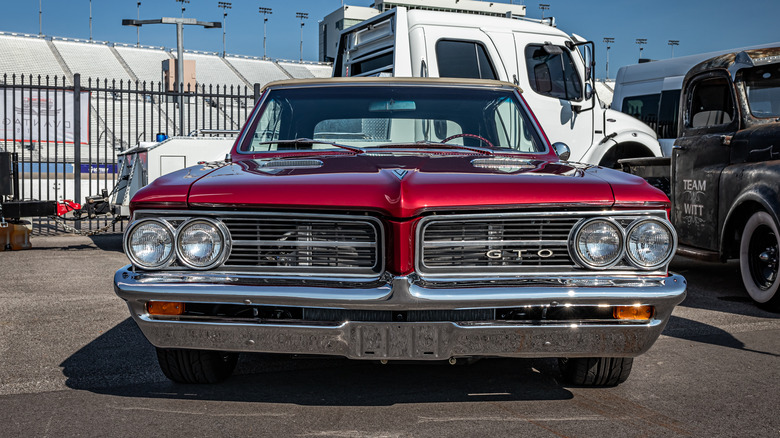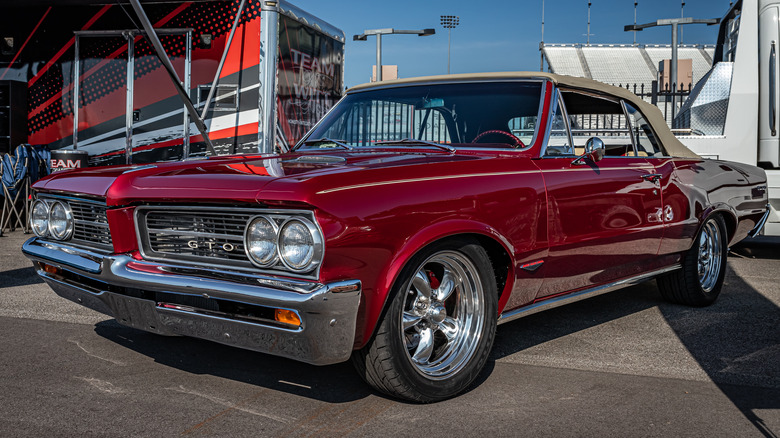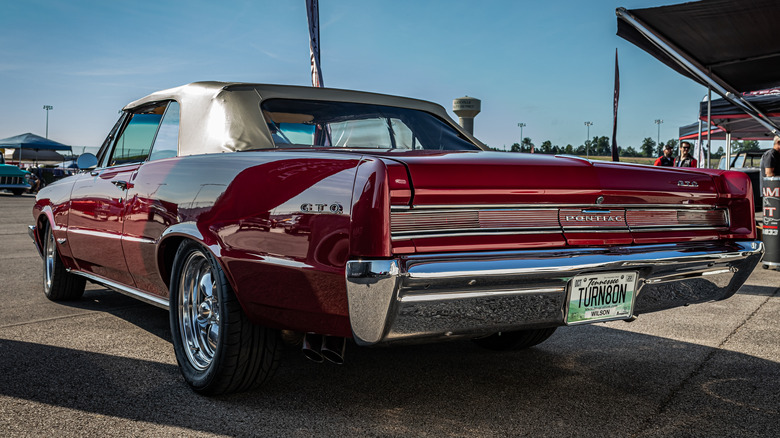What Made The 1964 Pontiac GTO A Legendary Part Of Muscle Car History
The American muscle car era began in the mid-1960s and lasted until the oil crisis and new emissions and fuel economy standards sent car buyers flocking to smaller models in the early to mid '70s. During the muscle car era's heyday, Detroit's Big Three automakers churned out legends like the the legendary Chevy Corvette, equally iconic Ford Mustang, and speedy pop culture favorite, the Dodge Charger. Pontiac is often credited with lighting the tires on the muscle car era with the 1964 GTO, when the badge was first used on a special edition of the Tempest LeMans.
In the 1950s, drag and stock car racing were big business for the Big Three. But Bill Vukovich's fatal crash at the 1956 Indy 500 and the massive wreck at LeMans that killed 84 spectators two weeks later prompted the Automobile Manufacturer's Association to order its members to de-emphasize racing and performance in advertising and production. GM, Ford, and Chrysler all carried on with semi-clandestine racing programs, but in February 1963, GM buckled under pressure from safety and insurance concerns and issued a memo banning any further racing support.
While Ford and Chrysler carried on with full-bore racing programs, GM turned its attention to the consumer market for high-performance cars. Engineer John DeLorean (the same man who created the company and car that later starred in the "Back to the Future" films) decided to drop Pontiac's racing-bred 389-cu-in V8 into the LeMans, and the GTO was born.
The GTO took its name from a Ferrari
GM's engineers had to get around an AMA-inspired policy that all vehicles had to weigh 10 pounds for each cubic inch of displacement. Automobile Catalog lists the '64 GTO's curb weight at 3,470 lbs, meaning the biggest engine allowed would be GM's 330-in V8. To get around this limitation, DeLorean and his team decided to make the 330 the base engine for the GTO and offered the 389 as an option. The acronym, which stood for "Gran Turismo Omologato," was used by Ferrari to designate a model that had been approved for homologation by the FIA.
DeLorean and his team thought the name gave Pontiac's new beast an exotic and powerful pedigree, and borrowed the name. The additional $295.90 for the LeMans GTO package brought the sticker price to $2,776 (just under $28,000 in 2024 dollars).
Standard rear-end gear ratios ranged from 3.08:1 to 3.90:1, although a dealer-installed 4:33.1 option and Pontiac's Safe-T-Track limited slip differential were available for buyers who wanted maximum acceleration. According to Hemmings, Pontiac sold 32,450 GTOs in 1964, and examples from that first year remain hot commodities today — a black 1964 GTO convertible sold recently for more than $107,000.
The GTO paved the way for the Mustang and Firebird
The 1964 GTO was offered with two carburetion packages. The base version was a Carter 4-barrel that supplied enough fuel to help the 389 produce 325 hp and 428-lb-ft of torque. An optional tri-power setup with three Rochester 2-barrels increased output to 358 hp and raised the torque peak from 3,200 to 3,600 rpm. The '64 GTO and the detour John DeLorean took around GM's restrictions helped clear the road for other legends of the era like the Mustang, which was introduced at that year's World's Fair. The first generation of the GTO ran through 1967 and helped bring Pontiac back into the fold as one of GM's more marketable brands. Pontiac's Firebird took the baton from the first-generation GTO in 1967 and sold more than 250,000 units in its first three years.
The original GTO was such a success that GM lifted the engine size restriction before introducing the second-generation GTO in 1968. The next year, a Judge performance package was added to the now-standalone model. This added wider tires, a Hurst shifter, and a Ram Air III intake that boosted the 400-cu-in V8's output to 366 hp. A 455-cu-in high output V8 was added for 1970; horsepower dropped to 360 but this engine could loosen dental fillings with its 500-lb-ft of torque. The new emissions laws that came soon after put the brakes on muscle car production, but without the 1964 GTO, the era might never have begun.


